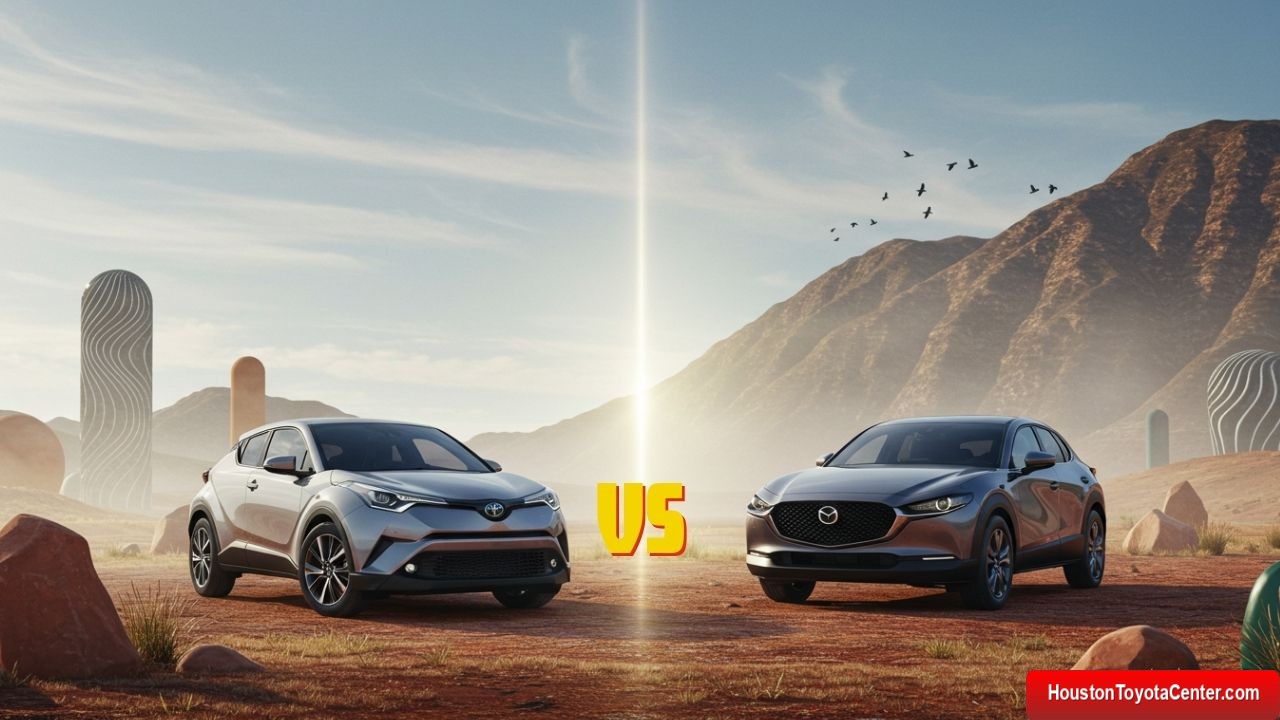The compact crossover segment has grown exponentially over the years, providing consumers with vehicles that offer the practicality of an SUV while maintaining the efficiency and driving dynamics of a smaller car. Two of the standout models in this category are the Toyota C-HR and the Mazda CX-30. Both vehicles bring their own unique blend of design, performance, technology, and safety to the table. In this detailed comparison, we will analyze their strengths and weaknesses to help you decide which one best fits your needs.
Exterior Design and Styling
Toyota C-HR
The Toyota C-HR is known for its bold and futuristic design. With sharp creases, an aggressive front fascia, and coupe-like lines, it stands out in a crowded market. The C-HR’s unique styling includes high-mounted rear door handles, a sloping roofline, and sculpted body panels, giving it a sporty aesthetic.
- Pros: Eye-catching design, sleek coupe-like silhouette, aerodynamic profile.
- Cons: The sloping roofline compromises rear visibility and headroom for rear passengers.
Mazda CX-30
Mazda has taken a different approach with the CX-30, opting for a more refined and sophisticated design. The Kodo design philosophy is evident, with smooth curves, an elegant front grille, and a premium appearance that rivals luxury brands.
- Pros: Upscale design, balanced proportions, and premium aesthetics.
- Cons: More conservative styling may not appeal to those looking for a bold look.
Verdict:
If you want a vehicle that turns heads with its unique and aggressive design, the Toyota C-HR is the better option. However, if you prefer a more sophisticated and luxurious look, the Mazda CX-30 wins this category.
FREE: Quickly identify and understand problems with your vehicle 🚘
CLICK HEREInterior and Comfort
Toyota C-HR
The interior of the Toyota C-HR is modern but leans more towards functionality than luxury. The dashboard features an 8-inch touchscreen with Apple CarPlay and Android Auto, and the overall layout is driver-focused. However, the rear seats can feel cramped due to the sloping roofline.
- Pros: User-friendly infotainment system, good front-seat comfort, high-quality materials.
- Cons: Limited rear headroom and visibility, cargo space is smaller than some competitors.
Mazda CX-30
Mazda is known for its upscale interiors, and the CX-30 is no exception. The cabin feels more like a premium vehicle, with high-quality materials, a minimalist dashboard, and a well-integrated infotainment system. The seats are comfortable and supportive, making long drives more enjoyable.
- Pros: Luxurious interior, high-quality materials, spacious rear seats, premium feel.
- Cons: Infotainment system can be complex for some users.
Verdict:
The Mazda CX-30 offers a more premium interior with better overall space and comfort, making it the winner in this category.
Performance and Driving Dynamics
Toyota C-HR
The Toyota C-HR comes with a 2.0L 4-cylinder engine producing 144 horsepower and 139 lb-ft of torque, paired with a continuously variable transmission (CVT). While it provides smooth and efficient driving, it lacks the sporty punch that some competitors offer.
- Pros: Good fuel economy, comfortable ride, reliable engine.
- Cons: Underpowered engine, CVT limits driving engagement.
Mazda CX-30
Mazda offers two engine options for the CX-30: a 2.5L 4-cylinder producing 186 horsepower and 186 lb-ft of torque, and a turbocharged version with up to 250 horsepower. Unlike the C-HR, the CX-30 uses a 6-speed automatic transmission, which provides a more engaging driving experience.
- Pros: Powerful engine options, fun to drive, responsive handling.
- Cons: Lower fuel efficiency compared to the C-HR.
Verdict:
For driving enthusiasts, the Mazda CX-30 is the better choice, offering a more powerful engine and a sportier driving experience. The Toyota C-HR, however, is ideal for those who prioritize efficiency over performance.
Technology and Infotainment
Toyota C-HR
The C-HR features an 8-inch touchscreen, Apple CarPlay, Android Auto, and a six-speaker sound system. While functional, the interface is not as refined as some competitors.
- Pros: Standard smartphone connectivity, simple interface.
- Cons: Outdated infotainment graphics, lack of physical controls.
Mazda CX-30
The CX-30 features an 8.8-inch display, controlled via a rotary dial instead of a touchscreen. While this setup may require a learning curve, it reduces distractions while driving. The available premium Bose sound system is another highlight.
- Pros: High-resolution display, premium sound system, intuitive controls.
- Cons: Lack of touchscreen functionality may not appeal to everyone.
Verdict:
The Mazda CX-30 has a more advanced infotainment system, though some may prefer the simpler touchscreen interface of the Toyota C-HR.
Safety Features
Both vehicles come with strong safety ratings and an array of driver assistance technologies.
Toyota C-HR
The C-HR includes Toyota Safety Sense 2.5+, featuring:
- Pre-collision system with pedestrian detection
- Lane departure alert with steering assist
- Adaptive cruise control
- Automatic high beams
Mazda CX-30
The CX-30 comes with i-Activsense, including:
- Blind-spot monitoring
- Lane departure warning
- Adaptive cruise control
- Rear cross-traffic alert
Verdict:
Both vehicles offer comprehensive safety features, but the CX-30 provides slightly more advanced options in higher trims.
Pricing and Value
Toyota C-HR
- Base Price: ~$24,000
- Top Trim: ~$28,000
- Best For: Budget-conscious buyers looking for reliability and efficiency.
Mazda CX-30
- Base Price: ~$24,500
- Top Trim: ~$35,000
- Best For: Buyers looking for premium features and a sportier drive.
Verdict:
The Toyota C-HR is the better choice for those looking for an affordable, reliable crossover, while the Mazda CX-30 provides more value for those willing to spend extra on premium features.
Conclusion
Both the Toyota C-HR and Mazda CX-30 are excellent compact crossovers, but they cater to different types of buyers:
- Choose the Toyota C-HR if you prioritize fuel efficiency, unique styling, and reliability at a lower cost.
- Choose the Mazda CX-30 if you value performance, luxury, and advanced technology.
Ultimately, the Mazda CX-30 emerges as the overall winner due to its superior driving dynamics, luxurious interior, and more powerful engine options. However, the Toyota C-HR remains a great option for those who prefer a distinctive look and proven reliability.


Leave a Reply